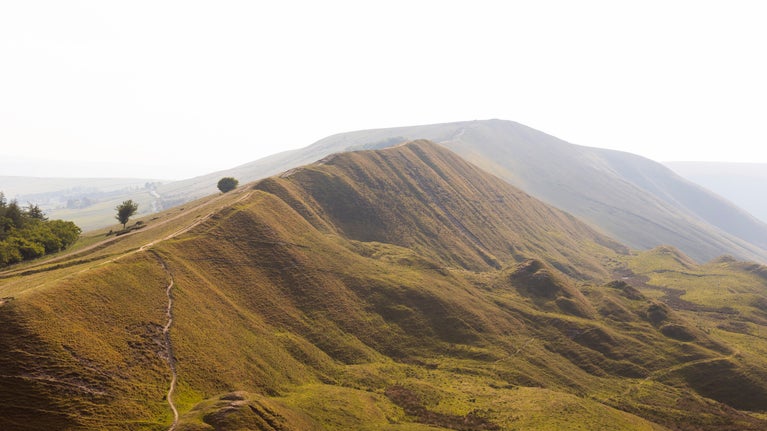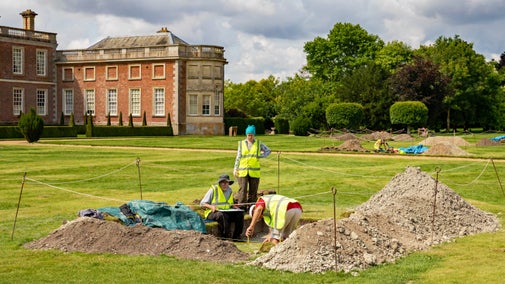
Archaeological work
We look after many rich and diverse archaeological sites. Archaeology helps us to learn more about them and protect them for the future.

We look after more than 90,000 archaeological sites across England, Wales and Northern Ireland, spanning one million years of human history and achievement. Follow the journey through British history through its archaeological artefacts, from the Prehistoric Period through to the 20th century.
Archaeology helps us understand the stories behind the places that we care for, revealing their long histories and the people connected to them. By uncovering lost landscapes, buildings, buried remains and artefacts, we can make connections with past communities and understand more about the lives they led.
The archaeological sites in our care include parts of 11 World Heritage Sites, more than 1,700 scheduled monuments (nationally important archaeological sites), and thousands of objects made by people in the past.
The Prehistoric Period, also called prehistory, is the span of time before written records or documented history.
It can be split into three eras: Palaeolithic (c. 800,000–10,000 BC); Mesolithic (c. 10,000–4000 BC); and Neolithic (c. 4000–2500 BC).
During the Palaeolithic Era, which is also known as the Old Stone Age, our ancestors used stone tools to hunt large animals. Early humans were largely foragers and hunters, who lived in caves or trees, kept in small groups and were dependent on their local environment for survival.
The Mesolithic Era, or Middle Stone Age, saw our hunter-gatherer ancestors start to use smaller, more advanced tools and develop more sophisticated techniques for getting their food.
Civilisations during the Neolithic Era, or New Stone Age, introduced farming. Clearing countryside and forests in their path, they cultivated crops and domesticated livestock, making permanent settlements and forming villages and communities. They created polished stone tools, pottery, weaving, and megalithic monuments like Stonehenge. This period is known for transforming Britain’s landscape and society and for laying the foundation for modern society.
Many people travelled from mainland Europe to Britain during the early Bronze Age, bringing with them a knowledge of metalworking, animals and trading goods. As such, Britons gradually learned how to make tools and weapons with copper, bronze and precious metals.
Settlements also became more structured, ranging from small villages to larger community sites, and often had distinct social hierarchies.
From around 800 BC, iron began to be used in tools and weapons, which is stronger, more available and more versatile than bronze. These stronger iron tools improved farming practices, leading to an increase in food production and a significant growth in Britain's population.
During the Iron Age, our ancestors tended to live in clans that were part of tribes, led by warrior kings. As these tribal societies emerged, there was an increase in new crafts and evolving religious practices, and trade continued to prosper as it had done in the Bronze Age.
Britain was invaded by the Roman army in 43 AD, and the occupation was very successful, very quickly. The conquered territory became known as the Roman province of Britannia. Evidence suggests that there was a relatively peaceful adoption of Roman rule and culture among the Britons.
The Romans built roads, villas and forts, and social buildings like temples, bathhouses and amphitheatres. As a result, Roman and local Briton cultures integrated during this period, offering new forms of entertainment, social spaces and places for worship. However, some areas resisted Roman rule, with rebellions and local traditions continuing despite Roman influence.
Roman occupation of Britain ended in 410 AD due to increasing political instability within the Roman Empire itself, so they withdrew their forces and administration from the distant province of Britannia.
Many warring tribes attacked and settled in different parts of Britain after the Roman withdrawal.
Coming from modern-day Germany, Denmark and the Netherlands, the largest tribes were the Angles, Saxons and Jutes. Local Anglo-Saxon (the term used to describe these new people and their descendants) settlements became more prominent, eventually forming larger, independent Anglo-Saxon kingdoms – the most powerful were called Northumbria, Mercia, Wessex, East Anglia, Essex, Kent and Sussex. These largely rural communities were structured around kings and princes with eldermen and earls beneath them.
Most Anglo-Saxons were farmers, but some were skilled metalworkers and craftsmen – and their products were a significant part of Anglo-Saxon culture. Archaeologists have uncovered many pieces of intricate jewellery and metalwork, and illuminated manuscripts, from this period.
From the late 8th century onwards, Vikings from modern-day Scandinavia began raiding and settling, leading to the blending of Norse and local cultures.
This period, also known as the Middle Ages, began when William of Normandy won the Battle of Hastings in 1066, defeating the Anglo-Saxon armies and being crowned king.
Defensive buildings like earthwork enclosures and towers, which then became grand castles and fortresses, spread across the landscape. The Hundred Years' War with France (1337–1453), and the Wars of the Roses between the Yorkist and Lancastrian dynasties (1455–1487), which ended with the rise of the Tudors, influenced political instability, warfare and territorial disputes.
Towns expanded, encouraging trade and the establishment of guilds. However, the Black Death, which struck in the mid-14th century, devastated populations. The rise of merchant wealth fuelled urban growth, and palaces and theatres flourished. Towards the end of the Medieval Period, naval power expanded, which aided exploration.
Christianity, which first appeared in Britain during the Roman Period, and slowly replaced paganism during the Early Medieval Period, now played a central role in daily life. Cathedrals, monasteries, churches and other religious houses spread and dominated landscapes. This was until King Henry VIII broke from the Catholic Church in the English Reformation, destroying many of these religious houses and persecuting anyone who refused to conform.
Spanning the Stuart Era, the English Civil War, the Georgian Period, early colonial expansion and the Industrial Revolution under the Victorians, these 200 years saw significant changes for the increasingly urbanised British society.
Archaeological evidence from the first half of this period includes battlefield remains and shipwrecks, reflecting Britain’s increasing economic and military power.
From around 1750, factories, railways and canals revolutionised transportation and production, reshaping landscapes. Rapid urbanisation led to overcrowding and poor working conditions.
During the 20th century, rail and road networks grew, as did the popularity and accessibility of the motor car; there were significant advancements in health and education; and the British Empire declined and then fell as many former colonies gained independence.
It also saw two global conflicts that irreversibly shaped Britain, and the world: the First and Second World Wars, from 1914–18 and 1939–45 respectively.
Despite British military success in both wars, its society was significantly fractured as there was conscription, rationing, censorship, taxation increases, and aircraft raids destroyed landscapes. These wars devastated countries, killing millions – both military personnel and civilians at home.
If you know where to look, archaeology is all around us. Archaeological sites and historical items help us know how our ancestors shaped, responded and related to the world around them.

We look after many rich and diverse archaeological sites. Archaeology helps us to learn more about them and protect them for the future.
The National Trust Heritage Records is an online database of over 90,000 archaeological sites. In 2021, nearly 2,250 new sites were added. Archaeologists and volunteers continue researching these historic places.

From hillforts to stone circles, gold mines and medieval castles, there's plenty to explore at the historic places in our care. Discover reminders of the past that tell the stories of our ancestors.

Our archaeologists uncover hidden stories and care for thousands of sites and objects. Learn how their work helps protect the past for future generations.
